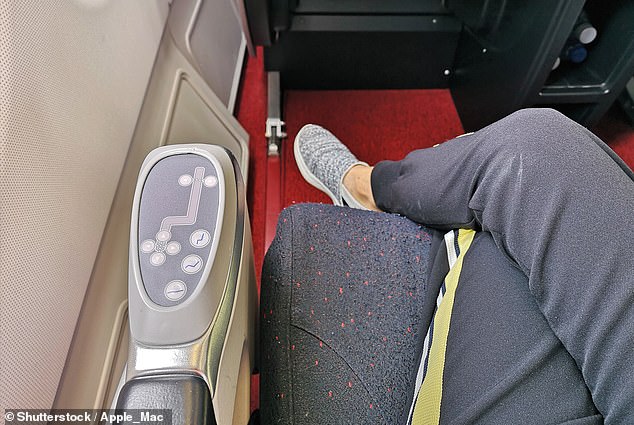Elderly passengers have been warned to avoid one common sitting position on a plane as it could be very risky.
Lee Cartwright, elderly care expert from Mobility Solutions Direct, has warned older passengers not to cross their legs on the plane.
He says: ‘Crossing your legs during a flight might seem harmless, but it’s actually one of the worst things you can do for your health while travelling.
‘It can lead to back and joint pain, and more seriously, it can restrict blood flow in your legs, increasing the risk of developing deep vein thrombosis.’
Deep vein thrombosis (DVT) is when a ‘blood clot forms in a vein’, usually a leg. It can be life-threatening if the clot travels to another part of the body.
Elderly passengers are particularly at risk from DVT, says Lee. He explains: ‘As we age, our circulation tends to slow, muscle strength declines and the valves in our veins may not work as effectively.
‘Additionally, other age-related health conditions like diabetes can make blood clots more likely.’
How to reduce your risk of DVT while flying

Lee Cartwright, elderly care expert from Mobility Solutions Direct , has warned older passengers not to cross their legs on the plane
Keep moving throughout the flight – Lee recommends getting ‘up every hour or so to stretch or walk up and down the aisle’. This can help to keep passengers’ legs active.
Keep your legs stretched when sitting – ‘Rather than sitting with your legs crossed, try stretching them out in front of you with a gentle bend at the knees,’ advises Lee. He explains that this will ‘keep your blood flowing properly’ and ‘take some of the strain off your lower back’.
Stay well hydrated – Lee recommends drinking lots of water throughout the flight as ‘hydration helps your blood flow more easily’.
Use compression socks – Lee explains: ‘Compression socks or stockings apply gentle pressure to your legs, which can help with blood circulation and reduce swelling.’
Do simple leg movements in your seat – Flexing your feet, rotating your ankles and ‘gently lifting your knees every 30 minutes’ can lower your risk of DVT, says Lee.
Symptoms of DVT
Swelling in one leg – Lee says: ‘A blood clot, or DVT, often leads to noticeable swelling in one leg, usually around the calf or thigh. The area might feel unusually firm or sore to touch.’
Increased cramping – ‘This can feel similar to a muscle strain or cramp,’ warns Lee. ‘It may become more uncomfortable when you’re walking or standing. You might also notice the area feels warm or looks a bit red.’

Elderly passengers are particularly at risk from DVT, says Lee
Discoloured skin – Lee says: ‘The skin over the clot may appear redder or darker than the surrounding area, and it can feel warmer than usual.’
Shortness of breath – The expert warns: ‘In more serious cases, a clot can move to the lungs and cause a pulmonary embolism. This can lead to sudden chest pain or difficulty breathing and it requires urgent medical attention.’
It comes after a pilot shared an easy remedy that can ease painful ears for everyone from adults to children, who often suffer more than the grown-ups they’re travelling with.
eSIM travel company Airalo sought the advice of pilot William Hosie, who explained: ‘Cabin pressure changes as you climb or descend in the plane. When the plane is at 35,000 feet, you’re breathing air in the cabin as if you’re at 6,000 feet.
‘The air is thinner and the air pressure is less, which is why some people have problems with toothache, and of course ears.’
This article was originally published by a www.dailymail.co.uk . Read the Original article here. .

